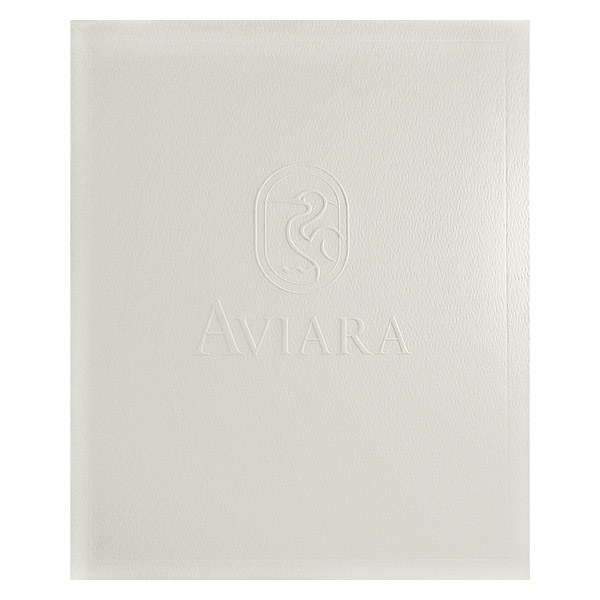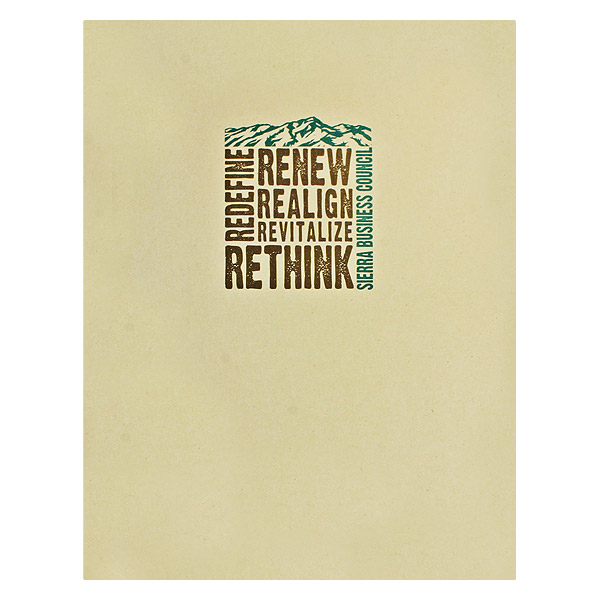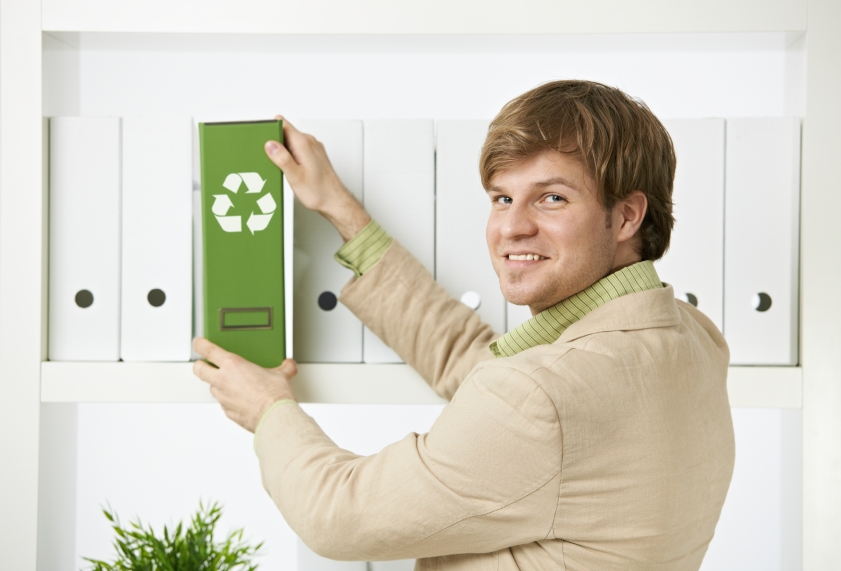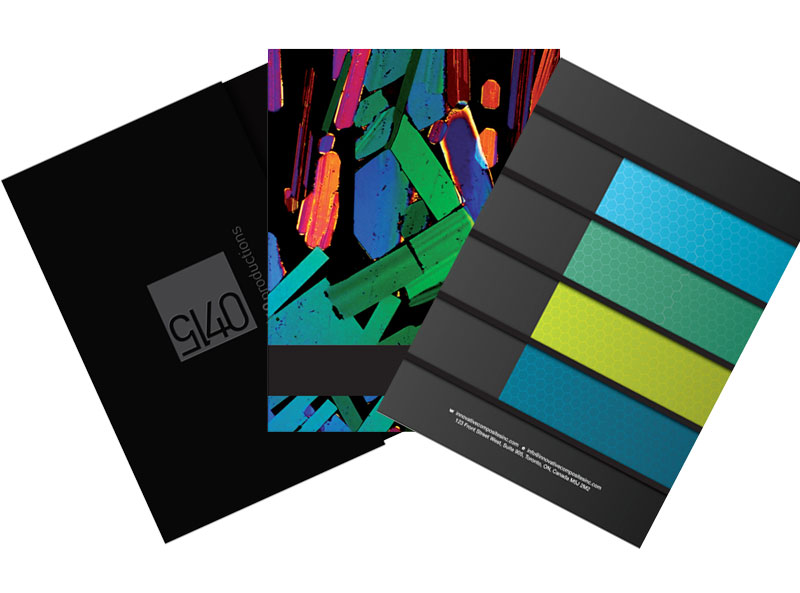 Paper is a renewable resource that can be easily recycled, yet paper products like presentation folders have an unfair reputation for being ecologically unfriendly. Paper manufacturers replant more trees than they harvest, helping to grow new forests and ecosystems. Meanwhile, in 2013 it was reported that over 63% of paper products used in the US were later recycled.
Paper is a renewable resource that can be easily recycled, yet paper products like presentation folders have an unfair reputation for being ecologically unfriendly. Paper manufacturers replant more trees than they harvest, helping to grow new forests and ecosystems. Meanwhile, in 2013 it was reported that over 63% of paper products used in the US were later recycled.
Ultimately, paper folders are okay to use as long as you make ecologically responsible choices. If you want to create a paper product that won’t keep your conscience up at night, follow our step-by-step instructions for designing the most eco-friendly folder possible.
Selecting a Printer
Eco-friendly printers usually highlight their green practices on their website; if not, you may want to contact them directly.
A few basic questions will likely spring to mind, but you should also consider elements that you might not immediately think of. For example, does the company…
- …recycle and use recycled materials for both products and shipping?
- …replant trees used to make paper stock?
- …reuse resources such as scrap paper?
- …use alternative means of electricity such as solar or wind power?
- …use carpools for transportation?
- …use energy-conserving lighting?
- …use energy-efficient computers and printing equipment?
- …use paperless offices?
You should also aim for a printer in your immediate area whenever possible. Buying local products is the best way to reduce your own carbon footprint–especially if you go pick up your order by walking or riding your bike to the print shop.
Supporting an eco-friendly company is only the first step of your journey. Next, it’s time to begin picking out the most eco-friendly product options.
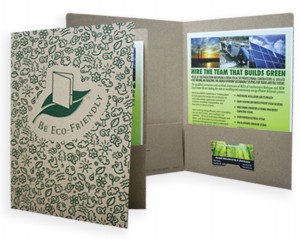
Use a stock made from 100% recycled post-consumer waste whenever possible.
Start with the right stock
For the ideal paper folder, seek out an unbleached stock made from 100% post-consumer waste; this means that the folder stock is made entirely from materials discarded by another consumer. Certain companies may even use paper made from non-tree materials such as bananas or coffee beans.
If you must use virgin paper (composed of fiber from a freshly cut tree), it’s best to use a printer with sustainable logging practices. This could include replanting every tree harvested or only using timber from a sustainable tree farm.
No coatings
Most folder varnishes and laminates are petroleum-based, and adding them to your product releases harmful VOCs into the atmosphere as well as using up valuable oil resources. These coatings also produce chemicals that interfere with your folder’s ability to be recycled or composted.
Certain printers may offer aqueous or soy-based coatings, which are more environmentally friendly but still require energy and resources to produce and apply to your folder. For the most “green” folder possible, your paper should remain uncoated by not selecting any coatings.
Choosing an imprint method
There are two different imprint methods that will make your folder look impressive without compromising your ideals.
Embossing/Debossing
Embossing and debossing are arguably the most eco-friendly types of printing available. These processes use heat and pressure to stamp your design directly into the stock itself. This creates a 3-D effect which can be felt with your fingertips. Without any ink at all, there are no VOCs to worry about.
Additionally, ink often has to be ordered or specially mixed, increasing the amount of carbon output your folder creates. Embossed presentation folders are manufactured directly at the printer, so the carbon footprint is much smaller.
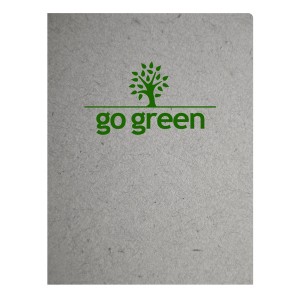
Agricultural-based inks are quick-drying and safer for the environment.
Agricultural-based inks
Agricultural-based inks can be used for both four-color process and PMS printing. This is a natural alternative containing a low level of VOCs (volatile organic compounds), hazardous chemicals found in many standard petroleum-based inks. Organic ink could include soy ink as well as other vegetable-based inks. It’s not only sustainable and more easily recycled; it’s also cost-effective and gives your product sharper clarity.
Minimalist design
Smaller, minimalist designs are more eco-friendly because they require less ink, heat and pressure to imprint.
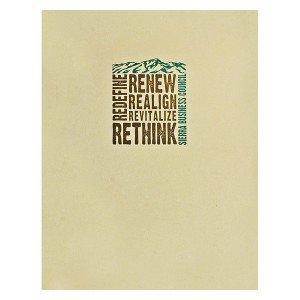
A smaller, more minimalist design requires fewer resources to print.
For example, if you’re using a larger design with embossed or debossed printing, it may require multiple imprints in different areas of your folder. A smaller design calls for only a single imprint area, saving both money and energy.
If you’re using the PMS printing method, remember that each new color requires a new application of ink. Stick to a monochromatic or one-color design to reduce the amount of ink and energy needed to create your folder.
Designing for reusability
The best folder designs are the ones that can be reused again and again for different presentations and occasions. Folders are printed in bulk, so it’s a waste if you have leftover unused folders because the design is outdated.
-
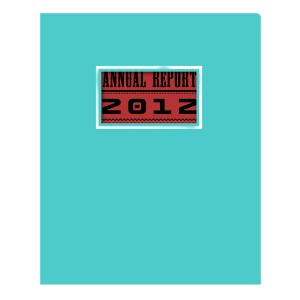
A die-cut window can make your presentation folders easier to reuse over the years.
Design with the big picture in mind, but always keep your focus squarely on your brand. What are your goals? What is your mission? What is the most important message about your brand that you want to deliver to all of your future clients, customers and business partners? Getting your message right the first time will ensure that your design lasts for years to come.
- Die-cut windows on the cover give you the option to change the overall look of your folder without ordering a new design. Whatever you place behind the window will show through to the cover, which lets easily you alter your design whenever the situation calls for it without needing to waste extra materials or energy.
Designing for durability
Do what you can to make a durable, heavy duty folder that lasts as long as possible. For example, a folder with multiple, complex die-cut designs may become easily torn. Rounded corners won’t become so easily dog-eared. Unglued folders won’t deteriorate over time.
Properly store your excess folders in a cool, dry place that’s out of the sunlight to help them last longer.

Reduce carbon emissions by placing your folder order via phone or e-mail.
Order by phone or e-mail
Whenever possible, try to work with your printer through telecommunication. Driving over to the print shop creates a lot of carbon emissions for no good reason.
The same goes for working with designers outside of your own company; use phone, e-mail and file sharing services to keep in touch with designers and discuss your folder design ideas.
No physical proofs or samples
The decision to order a physical sample or proof is difficult to make when you’re trying to stay eco-friendly. On one hand, sending a physical sample produces carbon emissions, yet on the other hand it allows you to catch any mistakes before accidentally printing an erroneous batch of folders, which cuts back on waste in the long run.
Opt for color digital proofs whenever you can-they are usually the most accurate representation of the final product, save for a few variations in tone and crispness due to the application of the design onto a stock. If digital proofs are not an option, order a physical proof only if there is reason to believe that your design might need tweaking before the final product.
No reruns
The most eco-friendly printers have procedures in place to conserve paper by catching errors before actually beginning your print job. Each folder is put through an extensive review process at each step of the construction process, from initial printing to the cutting and the folding of the stock. At each stage, a make-ready copy is created to catch any errors, such as jagged die-cuts or a misprinted ink layer.
This prevents the printer from having to rerun an entire batch of folders because of an error. Any printing service claiming to be eco-friendly should adhere to this level of commitment when it comes to quality assurance.
Eco-friendly packaging
Remember that the packaging your folders arrive in will likely be made of paper as well. If you want your entire shipment to be eco-friendly, ensure that your printer uses recycled or recyclable packaging materials too.
 Don’t pickup by car
Don’t pickup by car
If you want to conserve gas, your first thought might be to pick up your completed folders from the printer yourself; surely your car uses less gas than those big shipping trucks, right?
Actually, there’s a good chance that having your order shipped to you will use less gas than picking it up yourself. Yours isn’t the only shipment being delivered, after all, and the distance between your address and the delivery truck’s previous stop could be much less than the distance to the print shop. You should only pick up your folders if you can do so without consuming gas; either by foot, bike, or carpooling with someone who’s traveling to that area anyway.
Ship locally by ground
Always buy your paper products from local companies since overseas shipping greatly increases the size of your carbon footprint. It’s better to order standard shipping through ground mail than overnight shipping through air mail as traveling by truck requires fewer carbon emissions.
Companies like UPS and FedEx now practice carbon offset shipping, donating money to eco-friendly causes such as reforestation and wastewater treatment. This helps to balance out the carbon emissions produced by shipping your folders. Most printers use these shipping options or (at the very least) allow you to use whatever printing service you like at your own cost.
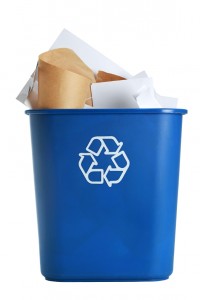
Ensure that your folders are properly disposed of.
Recycle, don’t trash
Nothing lasts forever, not even a quality folder. When you’re ready to dispose of your folder, be sure it ends up in the recycling bin. Alternatively, you may be able to compost certain folder stocks if they do not contain chemical coatings or bleach.
Add an eco tag on the back of your folder to let recipients know that it’s made from recycled material. This makes them more likely to recycle the folder when they’re done with it.
Whenever you hand out your eco-friendly folder to someone, be sure to impart the importance of recycling the folder properly. Let them know what options are available to encourage them to make the right decision.
Conclusion
You can apply these strategies to all of your paper marketing collateral; not only will you be doing your part to save the Earth, you’ll make a good impression with your eco-friendly clients and business associates.
This post is a part of our Presentation Folders 101 product guide.

